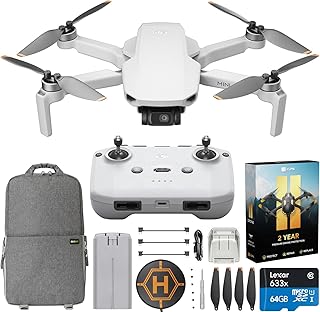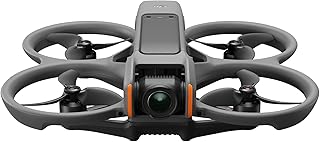DJI Drones: Use Cases and Applications in Various Industries
DJI drones, known for their user-friendliness, advanced features, and affordability, have revolutionized various industries, offering innovative solutions for diverse applications. Here's a breakdown of their use cases across different sectors:
1. Aerial Photography & Videography:
* Real Estate: Capturing stunning aerial shots of properties, enhancing marketing materials and showcasing the property's surroundings.
* Film & Television: Providing breathtaking cinematic shots, achieving unique perspectives and minimizing the need for expensive, complex filming techniques.
* Tourism & Travel: Offering aerial views of iconic landmarks, landscapes, and events, attracting tourists and promoting destinations.
* Wedding & Event Photography: Capturing memorable moments from a unique angle, adding a special touch to wedding videos and event documentation.
2. Agriculture:
* Precision Farming: Conducting crop health monitoring, analyzing soil conditions, and optimizing irrigation and fertilization based on aerial data.
* Pest Control: Identifying and tracking crop pests, minimizing the use of pesticides and improving crop yields.
* Livestock Management: Monitoring livestock health, tracking herd movements, and assessing grazing areas.
* Field Mapping & Surveying: Creating detailed maps and 3D models of farmland for efficient land management and planning.
3. Infrastructure Inspection & Maintenance:
* Power Lines & Transmission Towers: Inspecting for damage, corrosion, and other anomalies, ensuring safe and reliable electricity distribution.
* Bridges & Structures: Monitoring structural integrity, detecting cracks and wear, and planning maintenance interventions.
* Pipelines & Gas Lines: Inspecting for leaks, corrosion, and vegetation encroachment, ensuring safe and efficient operation.
* Solar Panels: Checking for faults, soiling, and panel performance, optimizing energy production.
4. Search & Rescue:
* Disaster Relief: Locating missing individuals, assessing damage, and providing vital information to rescue teams during natural disasters.
* Wildlife Conservation: Tracking endangered animals, monitoring wildlife populations, and identifying poaching activities.
* Police & Law Enforcement: Investigating crime scenes, surveying areas, and monitoring large crowds.
* Emergency Response: Reaching inaccessible areas quickly, providing real-time aerial surveillance and communication in emergency situations.
5. Surveying & Mapping:
* Construction & Engineering: Creating precise 3D models of construction sites, monitoring progress, and optimizing project planning.
* Mining & Quarrying: Mapping mineral deposits, monitoring mining operations, and ensuring safety.
* Urban Planning & Development: Creating detailed maps of urban areas, analyzing land use, and planning infrastructure projects.
* Environmental Monitoring: Assessing land use change, deforestation, and pollution levels, contributing to environmental protection.
6. Delivery & Logistics:
* Package Delivery: Delivering goods to remote areas, reducing delivery times and minimizing transportation costs.
* Emergency Supplies: Delivering critical supplies to disaster-stricken areas, where traditional transportation is unavailable.
* Inspection & Monitoring: Inspecting infrastructure, pipelines, and power lines, ensuring efficient and safe operation of logistics networks.
* Data Collection & Analysis: Gathering data on traffic patterns, delivery routes, and environmental conditions for optimizing logistics operations.
7. Public Safety:
* Traffic Monitoring: Monitoring traffic flow, identifying congestion points, and improving traffic management.
* Crowd Control: Monitoring large crowds, detecting potential safety hazards, and assisting in crowd management.
* Crime Prevention: Patrolling neighborhoods, identifying suspicious activity, and assisting in investigations.
* Border Security: Monitoring borders, detecting illegal crossings, and enhancing national security.
8. Scientific Research:
* Environmental Studies: Studying wildlife, ecosystems, and climate change, collecting data on vegetation, water quality, and pollution levels.
* Archaeological Research: Mapping ancient sites, identifying archaeological artifacts, and documenting historical structures.
* Geological Research: Monitoring geological formations, identifying potential natural hazards, and studying landforms.
* Medical Research: Conducting aerial surveillance of mosquito breeding grounds, tracking disease outbreaks, and supporting medical research.
Benefits of DJI Drones in Various Industries:
* Increased Efficiency: Streamlining workflows, saving time and resources, and optimizing processes.
* Enhanced Safety: Reducing risks associated with manual inspections and operations, ensuring worker safety.
* Improved Accuracy: Providing precise data and insights, leading to more accurate decision-making.
* Cost-Effectiveness: Reducing operational costs, minimizing labor requirements, and maximizing return on investment.
* New Opportunities: Opening up new possibilities and applications, transforming traditional industries and driving innovation.
Limitations & Challenges:
* Regulations & Licensing: Navigating complex regulations and obtaining necessary permits for drone operation.
* Battery Life & Range: Limited flight time and range, requiring careful planning and logistical considerations.
* Weather Conditions: Susceptibility to wind, rain, and other weather conditions, affecting operation and data quality.
* Data Security & Privacy: Ensuring data privacy and security, complying with data protection regulations.
* Operator Skill & Training: Requiring skilled operators with appropriate training and certifications for safe and effective operation.
Conclusion:
DJI drones have emerged as powerful tools, transforming industries and creating new opportunities. Their versatility, affordability, and user-friendliness make them accessible to diverse sectors, driving innovation and pushing the boundaries of what's possible. However, understanding the limitations and challenges associated with drone technology is crucial for successful implementation and responsible use. As technology advances, we can expect to see even more innovative applications of drones in the future.


